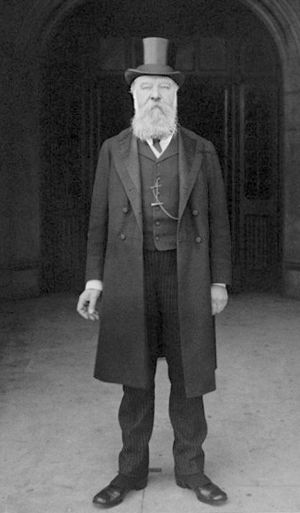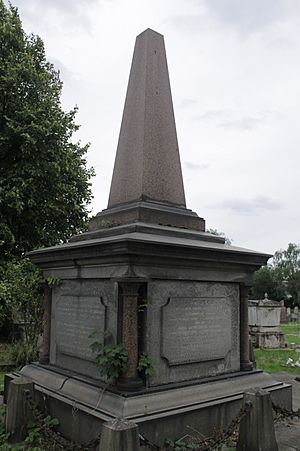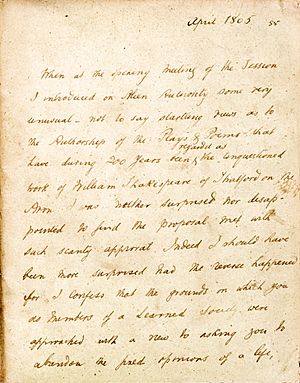Edwin Durning-Lawrence facts for kids
Quick facts for kids
Sir Edwin Durning-Lawrence, Bt
|
|
|---|---|
 |
|
| Member of Parliament for Truro |
|
| In office 1895–1906 |
|
| Preceded by | John Charles Williams |
| Succeeded by | George Hay Morgan |
| Personal details | |
| Born | 2 February 1837 |
| Died | 21 April 1914 (aged 77) |
| Political party | Liberal Unionist |
| Spouse | Edith Jane Smith |
| Occupation | Politician, author |
Sir Edwin Durning-Lawrence, 1st Baronet (born February 2, 1837 – died April 21, 1914) was a British lawyer and politician. He served as a Member of Parliament (MP) in the UK.
He is most famous for believing that Francis Bacon wrote William Shakespeare's plays. This idea is called the Baconian theory. Edwin Durning-Lawrence wrote many books about this and often debated with experts. When he died, he gave his large collection of books and papers to London University.
Contents
Life of Edwin Durning-Lawrence
Edwin Lawrence was born in 1837. He was the seventh son and last child of William Lawrence and Jane Clarke. His father made a lot of money in construction. He also held important political jobs in London.
Edwin's brothers, Sir William Lawrence and Sir James Lawrence, both became Lord Mayor of London. They were also members of parliament. His nephew, Frederick Pethick-Lawrence, was also an MP. He was known for supporting women's right to vote.
Becoming a Lawyer and Politician
Edwin studied law at London University. In 1867, he became a barrister, which is a type of lawyer who argues cases in court. Later, he became a Justice of the Peace in Berkshire. This role involves dealing with minor legal cases.
In 1895, he was elected to the House of Commons. This is where laws are made in the UK. He represented the area of Truro for the Liberal Unionist Party. He was an MP from 1895 to 1906.
Family and Special Title
In 1874, Edwin married Edith Jane Smith. They had one son, Edwin, in 1878, but he sadly died two days later.
On February 2, 1898, Edwin changed his name to Durning-Lawrence. He did this to honor his wife's mother's family. Soon after, on March 10, 1898, he was given the special title of 1st Baronet Durning-Lawrence. This title is passed down through families. However, because he had no male heir, his baronetcy ended when he died.
Edwin Durning-Lawrence was also a strong supporter of Unitarianism. This is a type of Christian faith. He and his brother James gave a lot of money to help build the Essex Street Chapel. This chapel was an important center for Unitarianism in Britain.
He is buried in Kensal Green Cemetery in London.
Edwin Durning-Lawrence's Writings
Durning-Lawrence wrote many books. Some of his early works include The Progress of a Century (1886) and A Short History of Lighting (1895).
His Belief About Shakespeare
He became most famous for his strong belief in the Baconian theory. He read a book called The Great Cryptogram by Ignatius L. Donnelly. This book convinced him that Francis Bacon wrote Shakespeare's plays.
Durning-Lawrence wrote several books about this idea. His most well-known book was Bacon is Shake-Speare (1910). He also wrote The Shakespeare Myth (1912) and "Macbeth" Proves Bacon is Shakespeare (1913).
He believed that Bacon had hidden secret codes, called cyphers, within the plays. He thought finding these codes would prove Bacon was the true author.
Durning-Lawrence was very passionate about his views. He often spoke strongly against the idea that William Shakespeare of Stratford wrote the plays. He even sent copies of his book to libraries and schools. This worried some Shakespeare scholars, who thought people might be misled.
Famous Arguments
One of Durning-Lawrence's most famous arguments was about a long word in the play Love's Labour's Lost. The word is Honorificabilitudinitatibus. He suggested it was an anagram for a Latin phrase: hi ludi, F. Baconis nati, tuiti orbi. This means "these plays, F. Bacon's offspring, are preserved for the world." He got this idea from an earlier book.
However, later scholars pointed out problems with this anagram. For example, Samuel Schoenbaum noted that Bacon's name in Latin would be Baconi, not Baconis. Another scholar, John Sladek, showed that the same word could be rearranged to "prove" that Ben Jonson wrote the plays instead!
Durning-Lawrence also claimed that the famous Droeshout engraving of Shakespeare contained hidden clues. He thought it showed "two left arms and a mask," suggesting it was a secret picture.
University of London Archive
In 1929, Durning-Lawrence's large collection of books and papers was given to the Senate House Library at the University of London. It was officially set up there in 1931.
This collection is very important. It has about 7,000 books, mostly from the 1600s. It includes one of the best collections in the world about Francis Bacon. It also has valuable books about Shakespeare and Daniel Defoe.
Durning-Lawrence also left money to the university. This money was later used to create a special teaching position (a chair) in History of Art at University College. Even though Durning-Lawrence himself wasn't especially interested in art history, his gift helped this subject grow at the university.



